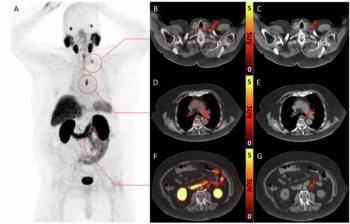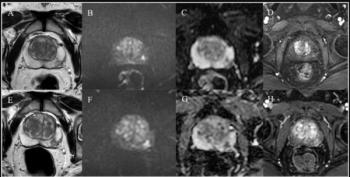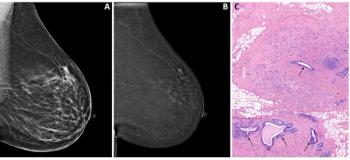New research findings from a prospective study suggest that fluorine-18-PSMA-1007 positron emission tomography/computed tomography (PET/CT) offers improved diagnostic accuracy over multiparametric MRI (mpMRI) for a number of factors that impact locoregional staging of prostate cancer.
For the phase II study, recently published in JAMA Oncology, researchers compared pre-operative use of 18F-PSMA-1007 PET/CT vs. mpMRI in 134 patients (mean age of 62) who subsequently had radical prostatectomy procedures. Eighty-eight percent of the cohort had PI-RADS scores of 3 or higher, according to the study.
The researchers found that 18F-PSMA-1007 PET/CT had 11 percent higher accuracy than mpMRI at identifying the dominant nodule (94 percent vs. 83 percent) and 17 percent higher accuracy at identifying the final pathological tumor stage (45 percent vs. 28 percent). The study authors also noted that use of 18F-PSMA-1007 PET/CT provided a 20 percent higher accuracy for identifying the laterality of disease in comparison to mpMRI (64 percent vs. 44 percent).
“Based on our findings and those previously published for metastatic staging, the adoption of a single preoperative PSMA PET scan may potentially replace the trio of preoperative conventional imaging tests currently ordered (MRI, CT abdomen and pelvis, and bone scan) in certain patients with intermediate-risk and high-risk prostate cancer,” wrote lead study author Nikhile Mookerji, M.D., who is affiliated with the Division of Urology in the Department of Surgery at the University of Alberta in Alberta, Canada, and colleagues.
While the researchers no statistically significant difference between 18F-PSMA-1007 PET/CT and mpMRI for detection of seminal vesicle invasion (91 percent vs. 85 percent), they noted that 18F-PSMA-1007 PET/CT offered 12 percent higher accuracy in diagnosing extracapsular extension (75 percent vs. 63 percent), and a 25 percent higher sensitivity rate (58 percent vs. 33 percent).
“The finding that PSMA PET better diagnosed extracapsular extension due to the presumed higher spatial resolution of MRI imaging compared to PSMA PET was an unanticipated finding and may be a unique feature of the 18F-PSMA-1007 radioligand as this was not previously observed with first-generation gallium-based radioligands,” posited Mookerji and colleagues.
Three Key Takeaways
- Higher accuracy. 18F-PSMA-1007 PET/CT demonstrated higher accuracy than mpMRI in identifying the dominant nodule, pathological tumor stage, and laterality of disease for men with prostate cancer.
- Improved detection of extracapsular extension.The study found that 18F-PSMA-1007 PET/CT was more accurate in diagnosing extracapsular extension compared to mpMRI, which is a key consideration in preoperative planning for radical prostatectomy procedures.
- Potential to replace multiple tests. The study authors suggested that 18F-PSMA-1007 PET/CT could potentially replace multiple preoperative conventional imaging tests (including MRI, abdominal CT and bone scans) for patients with intermediate-risk and high-risk prostate cancer.
The study authors emphasized that the enhanced detection of high-risk factors such as extracapsular extension with 18F-PSMA-1007 PET/CT can play a key role in preoperative planning for radical prostatectomy procedures.
“For instance, preoperative knowledge of extracapsular extension may alter the decision to perform nerve-sparing techniques on the side with anticipated tumor extension. Similarly, it may alter the extent of margin that is sought during pericapsular dissection,” pointed out Mookerji and colleagues. “In this study, nearly two-thirds of patients were under-staged when using MRI compared to approximately 40% of men when using PSMA PET.”
(Editor’s note: For related content, see “PET/CT or mpMRI: Which is Better for Detecting Biochemical Recurrence of Prostate Cancer?,” “Study Shows PET MRI Offers Better Detection of Localized Prostate Cancer than mpMRI” and “Study: PET/MRI May Prevent Up to 83 Percent of Unnecessary Biopsies in Men with PI-RADS 3 Lesions.”)
In regard to study limitations, the authors noted they weren’t able to compare the nodal staging accuracy of the imaging modalities due to the lack of a standardized template for lymph node dissection at the time of surgery.































